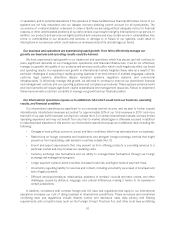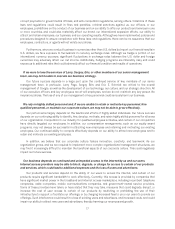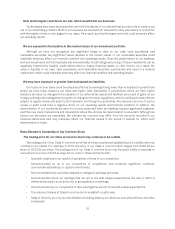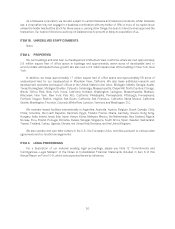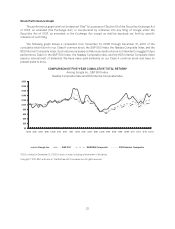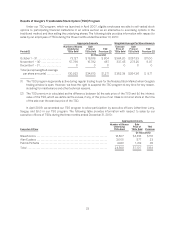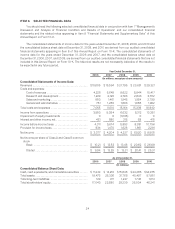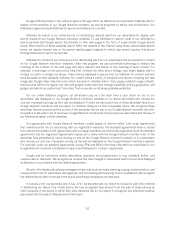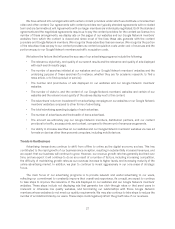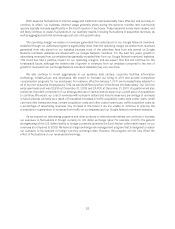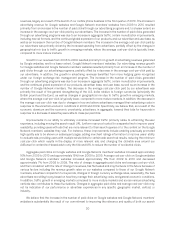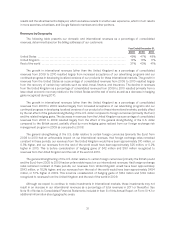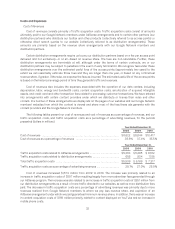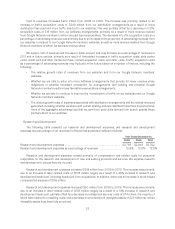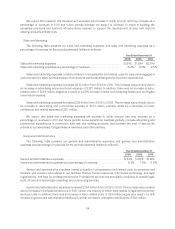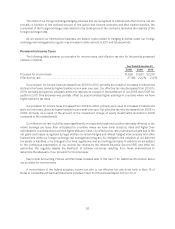Google 2010 Annual Report Download - page 39
Download and view the complete annual report
Please find page 39 of the 2010 Google annual report below. You can navigate through the pages in the report by either clicking on the pages listed below, or by using the keyword search tool below to find specific information within the annual report.Google AdSense refers to the online programs through which we distribute our advertisers’ AdWords ads for
display on the websites of our Google Network members, as well as programs to deliver ads on television. Our
AdSense programs include AdSense for search and AdSense for content.
AdSense for search is our online service for distributing relevant ads from our advertisers for display with
search results on our Google Network members’ websites. To use AdSense for search, most of our AdSense for
search partners add Google search functionality to their web pages in the form of customizable Google search
boxes. When visitors of these websites search either the website or the internet using these customizable search
boxes, we display relevant ads on the search results pages, targeted to match user search queries. Ads shown
through AdSense for search are text ads.
AdSense for content is our online service for distributing ads from our advertisers that are relevant to content
on our Google Network members’ websites. Under this program, we use automated technology to analyze the
meaning of the content on the web page and serve relevant ads based on the meaning of such content. For
example, a web page on an automotive blog that contains an entry about vintage cars might display ads for
vintage car parts or vintage car shows. These ads are displayed in spaces that our AdSense for content partners
have set aside on their websites. AdSense for content allows a variety of ad types to be shown, including text ads,
image ads, Google Video Ads, link units (which are sets of clickable links to topic pages related to page content),
themed units (which are regular text ads with graphic treatments that change seasonally and by geography), and
gadget ads (which are customized “mini-sites” that run as ads on AdSense publisher websites).
For our online AdSense program, our advertisers pay us a fee each time a user clicks on one of our
advertisers’ ads displayed on our Google Network members’ websites or, for those advertisers who choose our
cost-per-impression pricing, as their ads are displayed. To date, we have paid most of these advertiser fees to our
Google Network members, and we expect to continue doing so for the foreseeable future. We recognize these
advertiser fees as revenue and the portion of the advertiser fee we pay to our Google Network members as traffic
acquisition costs under cost of revenues. Google Network members do not pay any fees associated with the use of
our AdSense program on their websites.
Our agreements with Google Network members consist largely of uniform online “click-wrap” agreements
that members enter into by interacting with our registration websites. The standard agreements have no stated
term and are terminable at will. Agreements with our larger members are individually negotiated. Both the standard
agreements and the negotiated agreements require us to share with the Google Network member most of the
advertiser fees generated by users clicking on ads on the Google Network member’s website or, for advertisers
who choose our cost-per-impression pricing, as the ads are displayed on the Google Network member’s website.
For example, under our standard agreements, we pay 51% and 68% of the fees collected from advertisers to our
Google Network members in AdSense for search and AdSense for content, respectively.
Google ads for televisions enable advertisers, operators, and programmers to buy, schedule, deliver, and
measure ads on television. We recognize as revenue the fees charged to advertisers each time an ad is displayed
on television in accordance with the related agreements.
We also offer display advertising management services such as media planning, buying, implementation, and
measurement tools for advertisers and agencies, and forecasting and reporting tools for publishers. We recognize
the related fees as other revenues in the period advertising impressions are delivered.
In January 2010, we launched, and in July 2010, we discontinued, our direct-to-consumer web store channel
of distributing our Nexus One mobile phone. We had recognized fees derived from the sale of these phones as
other revenues in the period in which they were delivered. We do not expect to recognize any additional revenue
associated with the sale of these phones in the future.
26


